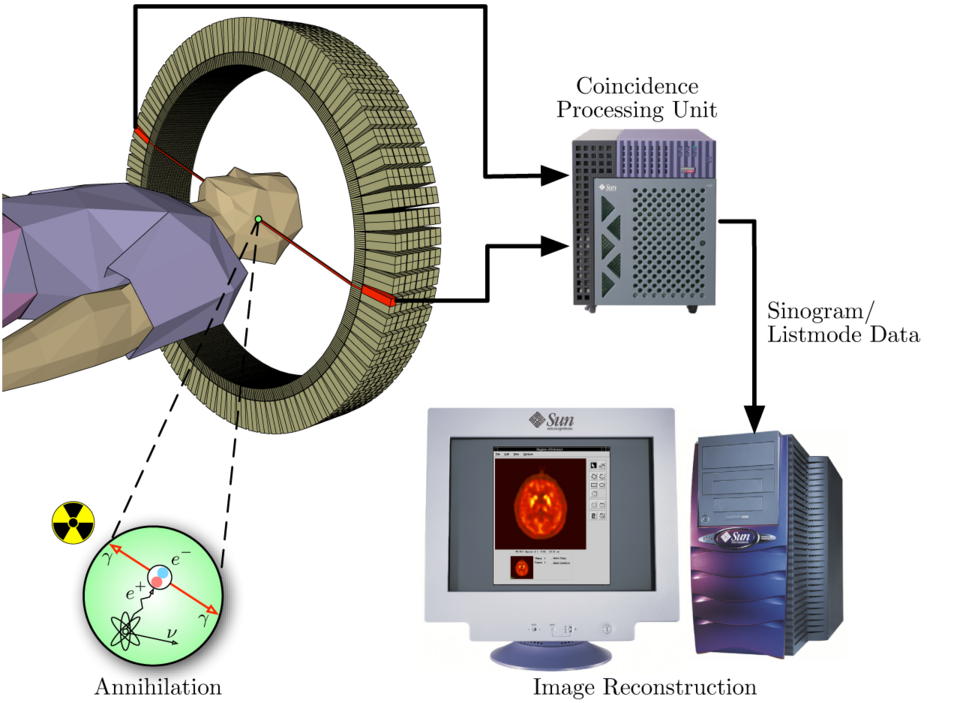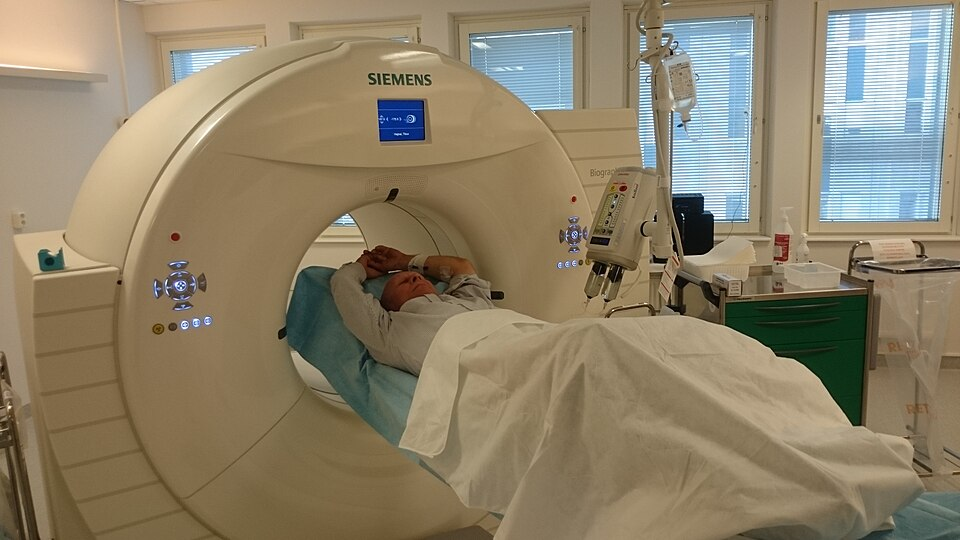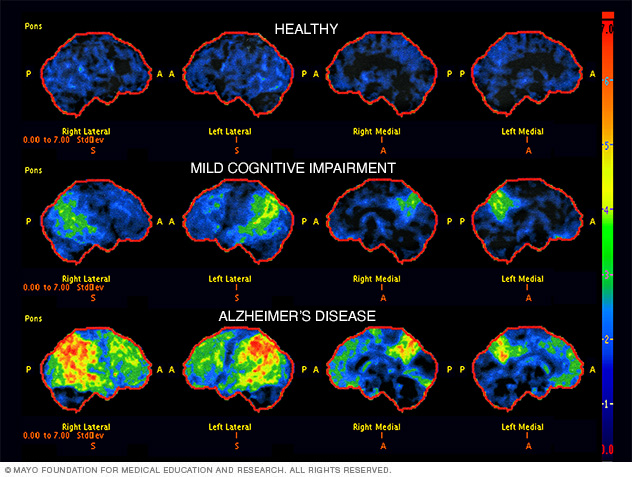IB Syllabus focus:
'- Basics of PET technology
- Uses in studying active brain regions
- Advantages and drawbacks'
PET scans, or Positron Emission Tomography scans, play a crucial role in psychology and neuroscience, offering detailed insights into the brain’s functional processes and aiding in the exploration of mental health conditions and cognitive activity.
Basics of PET Technology
Definition and Principles
PET scan is a nuanced nuclear imaging technology designed to observe metabolic processes in the body, with an emphasis on the brain. This is in contrast to MRI scans, which provide detailed images of the brain's structure.
It uses radioactive tracers, usually attached to glucose molecules, to showcase areas of high metabolic activity within the brain.
Process
After the injection of a radioactive substance, the scanner observes the gamma rays emitted by the tracer in living tissues.

This schematic illustrates the basic workflow of positron emission tomography: a positron emitted from the tracer annihilates with an electron, producing two gamma photons that are detected in coincidence by the surrounding detector ring and reconstructed into an image. The diagram focuses on detection geometry and coincidence processing, which explains how PET translates metabolism into 3D images. Source.
The brain’s active regions, having a high metabolic rate, absorb the glucose, emitting radiation detected by the scanner and converted into detailed 3D images. These images can help identify the localisation of function within the brain, offering insights into which areas are responsible for specific tasks.
The resulting images are coloured, each color depicting the level of activity within various regions, enabling an in-depth examination of regional brain metabolism.
Radiotracers
Fluorodeoxyglucose (FDG) is commonly used in PET scans to observe glucose utilisation and understand brain activity.
Different tracers can focus on specific biochemical processes, rendering PET versatile for studying varying physiological activities. This versatility is key in examining how the brain's function can change with neuroplasticity, highlighting the brain's ability to adapt and reorganise itself.
Technological Interaction
PET technology is often used in conjunction with CT or MRI scans to obtain both structural and functional information, providing comprehensive insights into brain anatomy and activity. This combination is crucial for understanding the complex interactions between the brain's structure and function, especially in relation to synaptic transmission.

Modern hybrid systems combine PET with CT in a single gantry so clinicians can fuse functional metabolism maps with high-resolution anatomy for precise localization. This photo shows a hospital-grade PET/CT scanner (Siemens Biograph) used widely in neurology and oncology. Source.
Uses in Studying Active Brain Regions
Investigation of Disorders
PET scans contribute significantly to diagnosing neurological disorders, including Alzheimer's, Parkinson’s, and epilepsy, allowing for monitoring progression and evaluating the effectivity of treatment plans.

FDG-PET scans comparing a healthy brain, mild cognitive impairment, and Alzheimer’s disease show progressive hypometabolism (cooler colors) in temporoparietal regions, a pattern used clinically to support diagnosis and staging. While color scales vary by lab, the trend of reduced glucose use with advancing disease is consistent. Source.
It aids in understanding the impact and efficacy of treatments and interventions on these disorders, evaluating the changes in brain activity pre and post-intervention.
Cognitive Studies
It’s invaluable in researching cognition, studying brain functions related to memory, attention, and language processing.
By identifying active brain regions during specific tasks, it provides insights into behavioural responses, cognitive development, and the underlying processes of various cognitive functions.
Psychological Research
PET scans are pivotal in examining and elucidating psychological conditions, exploring the neural substrates underlying them.
They facilitate intricate studies of brain-behavior relationships, helping to unravel the mysteries of human behavior and mental processes.
Drug Development
The scans offer insights into how medications interact with the brain, aiding in developing drugs that can target specific brain regions and neurotransmitter activities effectively.
These interactions are pivotal for researchers to develop effective treatments for various psychological and neurological conditions. The ethical considerations of using PET scans in research, particularly when involving animal studies, must always be carefully considered to ensure the welfare of subjects.
IB Psychology Tutor Tip: PET scans illuminate the brain's metabolic activity, offering insights into cognitive and psychological processes, crucial for understanding and treating neurological disorders with precision and depth.
Advantages and Drawbacks
Advantages
Detailed Insight
High Sensitivity: The ability to detect abnormalities at a molecular level offers unprecedented insights into minute metabolic processes and abnormalities within the brain.
In-depth Analysis: Providing extensive and detailed insights into brain metabolism and activity enables a more profound understanding of various psychological conditions.
Non-Invasive and Versatile
Non-Invasive Procedure: The ability to study live, functioning brains without surgical interventions or alterations is a significant advantage of PET scans.
Multiple Tracers: The use of various tracers can enhance the versatility of PET scans, allowing for the study of different biochemical processes within the brain.
Drawbacks
Radiation Exposure
Health Risks: Exposure to ionising radiation poses potential health risks, necessitating careful consideration of the frequency and necessity of scans.
Limited Repeated Use: The inherent risks related to radiation exposure limit the number of times a patient can undergo a PET scan.
Cost and Accessibility
Expensive: The high cost associated with PET scans makes them less accessible compared to other imaging techniques, limiting their widespread use.
Limited Availability: The necessity for specialized equipment and high operational costs result in limited availability, particularly in areas with constrained medical resources.
Resolution and Speed
Lower Spatial Resolution: PET scans have a comparatively lower spatial resolution than MRIs, affecting the detail in the images produced.
Time-Consuming: The requirement for the body to absorb the tracer means the procedure can be time-consuming, which might be a constraint in certain medical situations.
Practical Examples and Applications
Alzheimer’s Disease
Early Detection: The ability of PET scans to detect abnormal protein accumulations is instrumental in the early diagnosis of Alzheimer’s, allowing for timely intervention.
Treatment Planning: Regular assessments of disease progression through PET scans enable the formulation of effective treatment strategies and adjustments as needed.
Cancer Research
Tumour Identification: By observing cells with high metabolic rates, PET scans help in identifying cancerous tumors, which is pivotal for early intervention and treatment planning.
Treatment Monitoring: Regular scans are crucial for observing how cancer responds to treatment, allowing for timely alterations in treatment plans to enhance effectiveness.
Mental Health Studies
Understanding Depression: The insights provided by PET scans into the regions affected by depression facilitate the development of more targeted and effective treatments.
Schizophrenia Research: It is foundational in researching the functionality of brain regions implicated in schizophrenia, enabling the development of new therapeutic approaches.
Drug Development
Interaction Studies: Observing interactions between drugs and brain receptors is pivotal for developing new medications and assessing their potential impact on targeted brain regions.
Efficacy Testing: The insights gained from studying the alterations in brain activity due to drugs are essential in evaluating their effectiveness and potential as treatments.
IB Tutor Advice: Focus on the unique capabilities of PET scans in diagnosing and researching brain functions, and remember the significance of radiotracers in revealing diverse metabolic and cognitive activities.
Specific Use Cases and Contributions
Developmental Studies
By studying variations in brain activity across different developmental stages, PET scans contribute to our understanding of developmental psychology, observing how brain function evolves with age.
Neurological Studies
By focusing on neurotransmitter activity and brain metabolism, PET scans play a crucial role in neurological studies, deciphering the functional aspects of various neurological conditions.
Evolutionary Psychology
PET scans are integral in exploring the evolutionary aspects of human psychology, studying brain function and structures in relation to evolutionary adaptations and human behavior.
Learning and Memory Studies
In researching how different brain regions are activated during learning and memory tasks, PET scans offer insights into the neural substrates of memory formation, retention, and retrieval.
In essence, the benefits of PET scans in studying active brain regions are profound, providing in-depth insights and contributing significantly to various fields within psychology and neuroscience. The versatility and detailed analytical capability of PET scans have made them indispensable in contemporary research, despite the associated drawbacks and limitations. By leveraging the capabilities of PET technology, researchers and clinicians continue to enhance our understanding of the brain, paving the way for advancements in treatments, interventions, and our comprehension of human behavior.
FAQ
While PET scans are invaluable in studying numerous brain disorders, they are not universally suitable for all types. They are exceptionally effective in researching disorders linked to metabolic processes or abnormal brain activity, such as Alzheimer’s or epilepsy. However, for structural abnormalities, injuries, or certain developmental disorders where functional changes may not manifest through metabolic variations, other imaging techniques like MRI or CT scans may be more appropriate. The specific choice of imaging modality depends on the research question at hand and the nature of the brain disorder being investigated, taking into consideration the respective advantages and limitations of each technique.
PET scans have the potential to detect changes in brain activity associated with mental health conditions like depression and anxiety, offering insights into the underlying neurobiological mechanisms of these disorders. By observing alterations in metabolic activity in specific brain regions linked to mood regulation, emotion processing, and stress response, researchers can gain a deeper understanding of these conditions. However, it’s crucial to note that a diagnosis of depression or anxiety typically relies on clinical assessments and self-reports, rather than solely on brain imaging, as the manifestations of these conditions are multifaceted and influenced by a complex interplay of biological, psychological, and environmental factors.
Safety is paramount in PET scan studies. Researchers adhere to stringent protocols to minimise risks associated with exposure to radioactive tracers. The amount of radioactive substance used is meticulously calculated to be as low as possible to reduce potential harm, while still yielding valuable data. Participants are thoroughly informed about the procedure and potential risks, ensuring informed consent. Moreover, individuals with specific vulnerabilities, such as pregnant women or those with pre-existing health conditions, are usually excluded from studies involving PET scans. By adhering to ethical guidelines and prioritising participant well-being, researchers strive to maintain the utmost safety standards in conducting PET scan studies.
The use of radioactive tracers in PET scans indeed poses a significant challenge to longitudinal studies. The tracers have a short half-life, and they decay quickly, which means the scans must be conducted swiftly post-injection. This necessitates meticulous planning and precision in conducting studies. Furthermore, the exposure to ionising radiation from tracers limits the frequency of scans one can undergo, impacting long-term, repeated measure studies. The ethical concerns and potential health risks associated with radiation exposure, especially in vulnerable populations like pregnant women and children, also hinder the broader applicability of PET scans in long-term research endeavours.
PET scans differ substantially from CT scans, primarily focusing on metabolic processes and brain activity, rather than structural imaging. CT scans utilise X-rays to create detailed cross-sectional images of the brain’s anatomy, highlighting issues like tumours or injuries, but they don't provide information on brain function. On the other hand, PET scans, using radioactive tracers, can visualise areas of the brain that are active during specific tasks, yielding insights into the functional aspects of brain disorders, cognitive functions, and the impact of various neurological conditions on brain activity, hence offering a more comprehensive view of brain dynamics.
Practice Questions
PET scans are highly effective in identifying active brain regions as they offer detailed insights into metabolic processes, crucial for understanding various neurological and psychological conditions. They utilise radioactive tracers, revealing regions of high metabolic activity, thereby highlighting functioning brain areas during specific tasks. This is particularly useful in cognitive studies, allowing researchers to study brain functions related to memory, attention, and language processing. However, the limitations include exposure to ionising radiation, which poses potential health risks. Additionally, the scans are costly and have limited availability, and the procedure is time-consuming, with a lower spatial resolution compared to MRIs, impacting the detail of the resulting images.
PET scans significantly contribute to the understanding of neurological disorders like Alzheimer's and Parkinson’s by providing images of the brain’s active regions, enabling early detection and monitoring of disease progression. The scans visualise abnormalities in brain activity and metabolic processes, assisting in the diagnosis and evaluation of treatment efficacy. By assessing changes in brain activity due to interventions, PET scans are invaluable in developing and refining treatment strategies. This insight facilitates the formulation of targeted therapeutic approaches, allowing clinicians to alter treatments timely and effectively, paving the way for enhanced medical interventions and patient-specific treatment plans.

